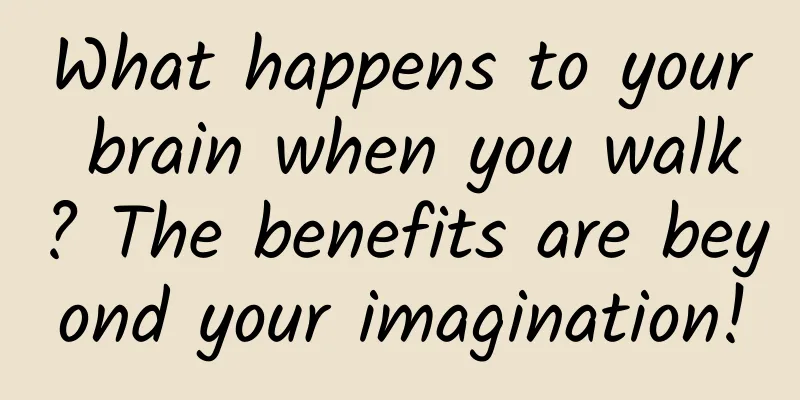What happens to your brain when you walk? The benefits are beyond your imagination!

|
In the fast-paced modern life, as people pay more attention to health, walking, an ancient form of exercise, has gradually been taken seriously. "Walking groups", "fast walking tribes" and "strolling partners" are all the rage in cities, hiking in the countryside has become a new fashion, and the "daily 10,000-step challenge" on social media and health apps is in full swing. In fact, walking not only exercises the body, but also helps the brain. Studies have shown that walking helps restore attention and mood. Not only that, but studies have also confirmed that just walking for 10 minutes can improve brain memory and even stimulate brainstorming, making you more creative. Copyright images in the gallery. Reprinting and using them may lead to copyright disputes. Walking helps restore your brain's focus and mood. Especially in parks A study published in the Proceedings of the National Academy of Sciences shows that walking can significantly improve cognitive abilities in older adults and help with mood management. In this study, participants in the experimental group were required to persist in walking training for 40 to 45 minutes three times a week for six months, while the control group only performed stretching and conditioning exercises. Compared with the control group, the elderly who persisted in walking showed significant increases in brain regions associated with attention control, including the middle frontal gyrus (MFG), superior frontal gyrus (SFG), and superior parietal lobule (SPL). These regions are closely related to higher cognitive functions such as executive function, decision making, working memory, self-control, and spatial attention. At the same time, walking training also led to a significant reduction in activity in the anterior cingulate cortex (ACC), which is associated with emotion regulation and conflict monitoring, and its reduced activity may help relieve stress and mood swings, further improving cognitive function. A 2024 study found that walking in a tree-lined park was more effective at restoring attention than walking on the streets or in commercial areas. The researchers found that although the participants walked for the same 40 minutes, they performed better on attention tasks when walking in the park. In addition, EEG recordings showed that the participants' brain theta waves increased significantly, indicating that their cognitive control ability was enhanced. In terms of subjective experience, walkers in the park generally felt that mental fatigue was relieved, concentration was improved, and they felt more significant psychological recovery. Therefore, when you feel your brain is tired and it is difficult to concentrate, it is better to take a walk in the park. Copyright images in the gallery. Reprinting and using them may lead to copyright disputes. Just a 10-minute walk, Improves brain memory There are now a lot of scientific studies telling us that exercise can help improve memory. Unfortunately, not everyone can spare the time or have enough physical strength to do moderate to high intensity exercise. However, another study published in the Proceedings of the National Academy of Sciences showed that even just 10 minutes of brisk walking can improve memory. In this study, participants in the experimental group performed 10 minutes of low-intensity exercise (such as walking or yoga), while the control group only sat and rested without any exercise intervention. Afterwards, all subjects needed to complete a memory discrimination task: the researchers first showed them a series of pictures of daily necessities and asked them to judge whether these items belonged to indoors or outdoors; then, in the recognition test phase, the participants needed to recall these items and judge whether they were exactly the same, had never appeared, or were similar to the previous pictures but different. During this process, the researchers recorded and compared the brain activity patterns of the experimental and control groups during the memory tasks. The results showed that compared with the control group, the experimental group had tighter connections between the dentate gyrus of the hippocampus (a brain area closely related to memory formation) and the cortical area responsible for processing detailed memory, and the degree of enhancement of these neural connections was positively correlated with the improvement of memory, that is, the stronger the connection, the more significant the improvement in memory ability. Copyright images in the gallery. Reprinting and using them may lead to copyright disputes. In this regard, the person in charge of the study said: "It is gratifying to see that more and more people are recording their exercise habits and the number of steps they walk every day. Even a short walk break during the day may have a considerable impact on improving memory and cognitive abilities." It is easier to stimulate brainstorming when walking. Creativity can be increased by more than 60% Many people may have had this experience: when thinking about a problem, they unconsciously pace back and forth. A study at Stanford University provides an explanation for this - walking can significantly improve creative thinking ability, and this effect is not limited to walking, but can even last for a period of time after walking. In the study, the researchers asked participants to complete a word association task (requiring participants to come up with new uses for a word) and a problem-solving task (such as imagining a new use for an object) in a variety of contexts. The specific experimental scenarios included: 1. Sitting vs. Walking 2. Sit first, then walk 3. Walk first, then sit 4. Indoor treadmill vs outdoor walking The results of the study showed that creativity increased by more than 60% when walking, and it was easier to generate new ideas than when sitting. What is more noteworthy is that walking can effectively improve creativity, whether on an indoor treadmill or walking outdoors. In addition, even after the walk is over, creativity is still higher than that of people who have been sitting, which shows that the positive effects of walking do not disappear immediately. The study also found that the effects of outdoor walking and indoor treadmill walking are similar, which suggests that the improvement in creativity mainly comes from walking itself, rather than changes in the surrounding environment. The researchers speculate that the reason why walking can improve creativity may be related to the following physiological and psychological factors: · Promote blood flow to the brain and enhance neural plasticity - more oxygen and energy supply, making thinking more agile. · Switch attention modes and break mental constraints - rhythmic movement allows the mind to flow more freely and helps to break out of fixed thinking patterns. · Reduce stress and improve mood – Walking promotes the secretion of dopamine and serotonin, which makes thinking more creative. Entering “wandering mode” – When you walk, your brain is more likely to enter a state of mind wandering and generate new ideas. In addition to improving concentration, memory, and creativity, walking can: Improve cerebrovascular health and reduce the risk of stroke. Increase brain-derived neurotrophic factor (BDNF), promote neuron growth, and improve learning ability. Reduce the risk of Alzheimer's disease and slow cognitive decline. Therefore, when you encounter a bottleneck in your thinking and don’t know how to solve the problem, you might as well try to stand up and walk around to get your brain moving! References [1]SJ Colcombe, AF Kramer, KI Erickson, P. Scalf, E. McAuley, NJ Cohen, A. Webb, GJ Jerome, DX Marquez, S. Elavsky, Cardiovascularfitness,corticalplasticity,andaging, Proc.Natl.Acad.Sci.USA [2]Hillman, C., Erickson, K. & Kramer, A. Besmart, exercise your heart: exercise effects on brain and cognition. Nat Rev Neurosci 9, 58–65 (2008). [3]McDonnell, AS, Strayer, DLImmersioninnatureenhancesneuralindicesofexecutiveattention. SciRep 14, 1845 (2024). [4]Suwabe, Kazuya, etal. "Rapidstimulation of humandentategyrus function withacutemildexercise." ProceedingsoftheNationalAcademyofSciences115.41(2018):10487-10492. [5]OppezzoM,SchwartzDL.Giveyourideassomelegs:thepositiveeffectofwalkingoncreativethinking.JExpPsycholLearnMemCogn.2014Jul;40(4):1142-52.doi:10.1037/a0036577.Epub2014Apr21.PMID:24749966. Planning and production Author: Hardy, PhD in Neurobiology, Zhejiang University Reviewer: Zhao Wei, Chief Physician, Department of Neurology, Tianjin University TEDA Hospital |
<<: Should I take medicine three times a day with my meals? Many people take it wrong...
>>: Please note that men can also get breast cancer!
Recommend
[Fat Bear Science] Saving, lazy, afraid, and acting, cancer likes these four words the most. The correct approach is...
Asking for trouble, looking for trouble, and suff...
How does the lettuce diet work? How to eat lettuce to lose weight?
Lettuce is a kind of vegetable that we often eat ...
What should I do if I can't marry the person I like? Do I really have to let go if I can't marry the person I like?
Many people's love is not smooth sailing. It ...
What are the most effective breast enhancement methods?
Nowadays, women are very concerned about their br...
20 kinds of bread red and black list: these 4 kinds are really not recommended
Many friends choose bread for breakfast, but ther...
Menopausal muscle pain
The muscle soreness during menopause is mainly ca...
Can eating raw peanuts really increase breast size?
Peanuts are a kind of crop. Many people eat peanu...
How many weeks can you stop taking progesterone?
Everyone must know the importance of progesterone...
What can a woman eat to get rid of spots on her face?
With the gradual increase of age, many dark spots...
Is teeth cleaning a waste of money?
More and more people are beginning to realize the...
Can I drink Tieguanyin during menstruation?
Women must pay attention to diet during menstruat...
12 days after medical abortion, brown blood
If a woman is not prepared for having a child and...
How long after giving birth should I lose weight?
Many mothers become obese after giving birth, whi...
White fluid discharge during pregnancy
A woman's body will undergo various changes a...





![[World Parkinson's Day] The appearance of these 10 symptoms may not mean you are old, but may be early signs of Parkinson's disease!](/upload/images/67f1455cc23f4.webp)



